On Constrained Intersection Representations of Graphs and Digraphs
Authors
Ferdinando Cicalese  ,
Clément Dallard
,
Clément Dallard  ,
Martin Milanič
,
Martin Milanič 
-
Part of:
Volume:
33rd International Symposium on Algorithms and Computation (ISAAC 2022)
Part of: Series: Leibniz International Proceedings in Informatics (LIPIcs)
Part of: Conference: International Symposium on Algorithms and Computation (ISAAC) - License:
 Creative Commons Attribution 4.0 International license
Creative Commons Attribution 4.0 International license
- Publication Date: 2022-12-14
File

PDF
LIPIcs.ISAAC.2022.38.pdf
- Filesize: 0.7 MB
- 15 pages
Document Identifiers
Subject Classification
ACM Subject Classification
- Theory of computation → Design and analysis of algorithms
- Mathematics of computing → Graph theory
Keywords
- Directed intersection representation
- intersection number
Metrics
- Access Statistics
-
Total Accesses (updated on a weekly basis)
0Document
0Metadata
Abstract
We study the problem of determining minimal directed intersection representations of DAGs in a model introduced by [Kostochka, Liu, Machado, and Milenkovic, ISIT2019]: vertices are assigned color sets, two vertices are connected by an arc if and only if they share at least one color and the tail vertex has a strictly smaller color set than the head, and the goal is to minimize the total number of colors. We show that the problem is polynomially solvable in the class of triangle-free and Hamiltonian DAGs and also disclose the relationship of this problem with several other models of intersection representations of graphs and digraphs.
Cite As Get BibTex
Ferdinando Cicalese, Clément Dallard, and Martin Milanič. On Constrained Intersection Representations of Graphs and Digraphs. In 33rd International Symposium on Algorithms and Computation (ISAAC 2022). Leibniz International Proceedings in Informatics (LIPIcs), Volume 248, pp. 38:1-38:15, Schloss Dagstuhl – Leibniz-Zentrum für Informatik (2022)
https://doi.org/10.4230/LIPIcs.ISAAC.2022.38
BibTex
@InProceedings{cicalese_et_al:LIPIcs.ISAAC.2022.38,
author = {Cicalese, Ferdinando and Dallard, Cl\'{e}ment and Milani\v{c}, Martin},
title = {{On Constrained Intersection Representations of Graphs and Digraphs}},
booktitle = {33rd International Symposium on Algorithms and Computation (ISAAC 2022)},
pages = {38:1--38:15},
series = {Leibniz International Proceedings in Informatics (LIPIcs)},
ISBN = {978-3-95977-258-7},
ISSN = {1868-8969},
year = {2022},
volume = {248},
editor = {Bae, Sang Won and Park, Heejin},
publisher = {Schloss Dagstuhl -- Leibniz-Zentrum f{\"u}r Informatik},
address = {Dagstuhl, Germany},
URL = {https://drops.dagstuhl.de/entities/document/10.4230/LIPIcs.ISAAC.2022.38},
URN = {urn:nbn:de:0030-drops-173239},
doi = {10.4230/LIPIcs.ISAAC.2022.38},
annote = {Keywords: Directed intersection representation, intersection number}
}
Author Details
Funding
This work is supported in part by the Slovenian Research Agency (I0-0035, research program P1-0285, research projects J1-3001, J1-3002, J1-3003, J1-4008, J1-9110, N1-0102, and N1-0160); and the GNCS group of the Italian "Istituto Nazionale di Alta Matematica - INdAM".
Acknowledgements
We would like to thank Andrea Caucchiolo for several insightful discussions we had on some of the results contained in this paper.
References
-
Andrea Caucchiolo and Ferdinando Cicalese. On the complexity of directed intersection representation of dags. In Donghyun Kim, R. N. Uma, Zhipeng Cai, and Dong Hoon Lee, editors, Computing and Combinatorics - 26th International Conference, COCOON 2020, Atlanta, GA, USA, August 29-31, 2020, Proceedings, volume 12273 of Lecture Notes in Computer Science, pages 554-565. Springer, 2020.

-
Andrea Caucchiolo and Ferdinando Cicalese. On the intractability landscape of digraph intersection representations. In Cristina Bazgan and Henning Fernau, editors, Combinatorial Algorithms - 33rd International Workshop, IWOCA 2022, Trier, Germany, June 7-9, 2022, Proceedings, volume 13270 of Lecture Notes in Computer Science, pages 270-284. Springer, 2022.

-
Marek Cygan, Marcin Pilipczuk, and Michał Pilipczuk. Known algorithms for edge clique cover are probably optimal. SIAM Journal on Computing, 45(1):67-83, 2016.

-
Hiroshi Era and Morimasa Tsuchiya. On intersection graphs with respect to uniform families. Utilitas Math., 37:3-11, 1990.

-
Hiroshi Era and Morimasa Tsuchiya. On intersection numbers of graphs. In Graph theory, combinatorics, algorithms, and applications (San Francisco, CA, 1989), pages 545-556. SIAM, Philadelphia, PA, 1991.

-
Paul Erdős, A. W. Goodman, and Louis Pósa. The representation of a graph by set intersections. Canadian Journal of Mathematics, 18:106-112, 1966.

-
Uriel Feige and Joe Kilian. Zero knowledge and the chromatic number. Journal of Computer and System Sciences, 57(2):187-199, 1998.

-
Harold N. Gabow. An efficient reduction technique for degree-constrained subgraph and bidirected network flow problems. In Proceedings of the Fifteenth Annual ACM Symposium on Theory of Computing, STOC '83, pages 448-456, New York, NY, USA, 1983. Association for Computing Machinery.

-
Alexandr V. Kostochka, Xujun Liu, Roberto Machado, and Olgica Milenkovic. Directed intersection representations and the information content of digraphs. In 2019 IEEE International Symposium on Information Theory (ISIT), pages 1477-1481. IEEE, 2019.

-
Lawrence T. Kou, Larry J. Stockmeyer, and C. K. Wong. Covering edges by cliques with regard to keyword conflicts and intersection graphs. Commun. ACM, 21(2):135-139, 1978.

-
Xujun Liu, Roberto Assis Machado, and Olgica Milenkovic. Directed intersection representations and the information content of digraphs. IEEE Trans. Inform. Theory, 67(1):347-357, 2021.

-
Carsten Lund and Mihalis Yannakakis. On the hardness of approximating minimization problems. J. ACM, 41(5):960-981, 1994.

-
James Orlin. Contentment in graph theory: Covering graphs with cliques. Indagationes Mathematicae (Proceedings), 80(5):406-424, 1977.

-
William R. Pulleyblank. FACES OF MATCHING-POLYHEDRA. ProQuest LLC, Ann Arbor, MI, 1973. Thesis (Ph.D.)-University of Waterloo (Canada).

-
Norman J. Pullman. Clique coverings of graphs - a survey. In Combinatorial mathematics, X (Adelaide, 1982), volume 1036 of Lecture Notes in Math., pages 72-85. Springer, Berlin, 1983.

-
Fred S. Roberts. On the mobile radio frequency assignment problem and the traffic light phasing problem. In Second International Conference on Combinatorial Mathematics (New York, 1978), volume 319 of Ann. New York Acad. Sci., pages 466-483. New York Acad. Sci., New York, 1979.

-
Fred S Roberts. Applications of edge coverings by cliques. Discrete applied mathematics, 10(1):93-109, 1985.

-
Alexander Schrijver. Combinatorial optimization. Polyhedra and efficiency, volume 24 of Algorithms and Combinatorics. Springer-Verlag, Berlin, 2003.

-
Morimasa Tsuchiya. On uniform intersection numbers. Ars Combin., 48:225-232, 1998.

-
Matteo Zeggiotti. On the complexity of the RDIN Problem. Master’s thesis, Master’s degree in Computer Science and Engineering, University of Verona, 2021.

